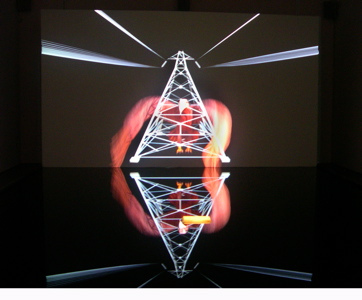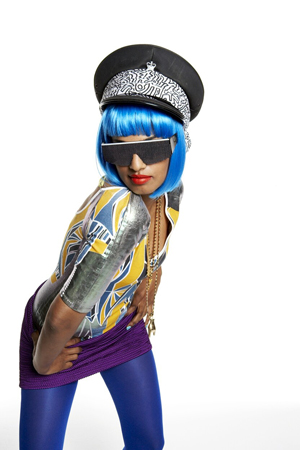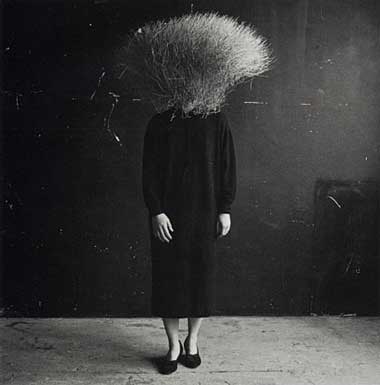
"Frustrum" Gary Hill 2007
If you didn't have the chance to attend video artist Gary Hill's lecture the other night at Reed, you may have missed one of the rarer opportunities to revisit the contemporary phenomena of existence with one of its most ardent investigators. While modern day philosophers do not exactly bombard the pop charts or the tabloids, and the sounds of our own voices seem almost silent in the event of our actual listening, the call to listen by someone who has dedicated a life's work to it is surprisingly grounding. Hill conducted the two hour lecture without a plan, yet seemed entirely relaxed ad libbing and even performing with a colleague in order to better recreate the experience of a piece to the audience. The artist was eloquent and comfortable speaking about his work, despite the height of its metaphysical parabola or the packed lecture hall before him. He expounded upon not only his most recent body of work, but began the lecture with work made in 1980. He spoke with the candor of conversation, citing his influence by the French writer and philosopher, Maurice Blanchot, in attempting to break apart the notions of existence through the questioning of language, perception and the accepted notions of thought and experience. Hill himself introduced his work as being entrenched in the "notion of the performative camera" as he intended to "open the image space, breaking open the idea of what we focus on". These ideological threads run consistently through Hill's oeuvre, despite its vast breadth of form. In many ways, Hill's work seems a visual continuation of the philosophical investigations surrounding phenomenology and reverberations of the earlier Dada-centric philosophies. Within a musical parameter, Hill's work hearkens to the "Early Works" of contemporary composer Steve Reich (in particular the piece, "Piano Phase") and the more pop-y,

M.I.A..
Both of these artists consistently break apart sound and language in order to more thoroughly, dramatically, and jarringly question the most prevalent sounds to which we have somehow stopped listening. The poet Harryette Mullen and the installation artist

"Untitled(Body Object Series), #5-bushhead 1984/1993, Ann Hamilton
Ann Hamilton also investigate similar subject matter.
If we understand the metamorphosis of language as existence, we can more aptly know Hill's investigation and code of symbolism. The architecture of a space, the subsequent physical movement through and within that space, and our scholastically accepted mode of communication (the spoken language) suddenly come into our perception as lyrical line drawing, as poetry, as concrete or folded paper; suddenly they have the possibility of a more pure form. In one piece, Hill pours sand into a speaker and watches as it jumps into the air with the vibrations of his voice and then bends the words that voice recites over and onto themselves in a seemingly infinite word play. Sound and symbol are activated multi-dimensionally; boundaries are everything and nothing, created only by given limitations.
Towards the end of the lecture, Hill expounded upon the ridiculous nature of the notion of "getting it", in regards to the futility of dissecting the intentions behind an artist's work and how revisiting older pieces was not an obsolete act for him because all time was simultaneous. He spoke of ghosts. The last question of the evening to Hill was whether or not he believed he made "romantic work". After a rather tangential response including the aspect of his romanticism being defined by his belief in his ability to embody something, the incredible complexity of looking at one's own hand long enough, and on the significance of a world rife with "virtual reality", he conceded with the statement, "Yeah, I make romantic work." In considering this closing statement after the nature of such a lecture, the notion of romance seems one applied to investigative thought involving the senses, the romance of questioning, and a description tantamount to the general write off of the age. This closing statement as a description of Hill's work was somewhat unsettling and dangerous when considering that romance now describes the method of some of the most astounding philosophical thought.
Hamilton spoke at Reed a few years ago: link here
Hill's talk was interesting if somewhat dated... but he does do a good job of making Derrida's deconstruction ideas less pretentious (no easy task). Back in the 70's and 80's deconstruction was all the rage and since text is an inherently parsing activity its use was natural.
Today with photoshop and finalcut taking something apart (visually) is a lot easier... It is also easier to put things together now too so it makes some of Hill's work look too technical (in a dated way that isnt bad, just a little retro like when stereo sound came out and sudddenly every record used very obvious panning). Still I thought "Site/Recite" was gorgeous and really brilliant until the very end with the cheesy computer generated mouth.... for once I'd advocate for pulling "a Lucas" and fixing that.
Overall, I love Hill's multiple CRT installations like "Clover" and "Inasmuch As It Is Always Already Taking Place" at MOMA... both are truly brilliant. Same with "Screen" I really enjoyed how he discussed the sine wave and wire mesh correlations at the talk. Also his insistance that the flat screens are better than CRT's for the latest version were right on. Its important not to get hung up on display nostalgia.
Still I feel like a lot of the computer generated animation works are kinda second rate compared to his best stuff like the piece at MOMA and "Clover", which though of a period are timeless.





















![[TypeKey Profile Page]](http://www.portlandart.net/nav-commenters.gif)